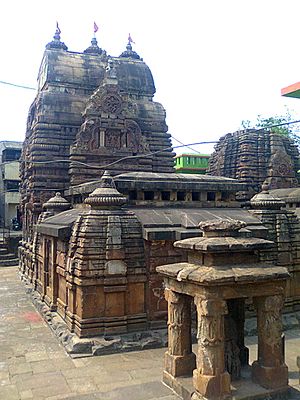Tribhuvana Mahadevi I facts for kids
Quick facts for kids Tribhuvana Mahadevi I |
|
|---|---|
| Paramavaishnavi, Katyayani | |
| Reign | 845-850 AD |
| Predecessor | Shubhakara-deva III |
| Successor | Santikara Deva II (Grandson) |
| Born | Goswamini Devi |
| Spouse | Santikara Deva I |
| House | Bhauma-Kara dynasty |
| Religion | Hinduism |
Tribhuvana Mahadevi I, also known as Paramavaishnavi Goswamini Devi, was a very important queen in ancient Odisha. She was the first female ruler of the Bhauma-Kara dynasty. She became queen of Tosali (an old name for Odisha) between 843 A.D. and 845 A.D. and ruled until 850 A.D.
Tribhuvana Mahadevi I took the throne after her son, Subhakara III, died too young. Some historians think she might have ruled even longer, until 863 A.D., before giving the throne to her grandson, Santikara II, when he was old enough. She was a very strong leader. Famous Arab and Persian travelers like Ibn Khordadbeh and Ahmad Ibn Rustah wrote about her great power and respect. She became queen even though some local kings in the region rebelled. Her powerful father helped her gain control. When she became queen, she compared herself to the powerful Goddess Katyayani. She is also known for building the Baitala Deula temple in Bhubaneswar. This temple is one of the oldest still standing in Odisha.
The Queen's Background and Character
Historians are not completely sure where Tribhuvana Mahadevi I came from. Some believe she was the daughter of King Rajamalla I from Mysore. Others think she was the daughter of a king from the early Eastern Ganga dynasty. This dynasty was a neighbor to the Bhaumakara kingdom in the south.
Records show that an earlier Bhaumakara king, Sivakara I, had defeated the Eastern Gangas. But then he helped them regain power after they agreed to be under his rule. This created a good relationship between the two royal families. It is possible this led to marriages between them.
Later kings wrote that Tribhuvana Mahadevi I had three special energies. These were Mantra Shakti (power from divine chants), Prabhu Shakti (spiritual power), and Utsaha Shakti (energetic power). She was also described as a Pitrabhakta, meaning she was very devoted to her parents. Her own royal records say she had many good qualities that made her a great ruler. She was a devout Vaishnavite, meaning she worshipped the god Hari. Because of this, she took the title Paramavaishnavi.
Becoming Queen
Tribhuvana Mahadevi I's own records describe how she became queen. They say that powerful local kings bowed down to her, showing their loyalty. The footrest of her late husband's throne shone brightly with the jewels from their crowns.
Before her husband, Santikara I, became king, the Pala dynasty king Devapala had defeated the Bhaumakara rulers. This made the Bhaumakara kingdom lose its power and respect. After this defeat, there was a lot of disorder. When Santikara I and then her son Subhakara III died, some local kings rebelled.
Later Bhaumakara kings wrote that the widowed queen took on the huge responsibility of ruling the entire kingdom. They said she was like the mythical serpent Shesha, who holds up the whole Earth. The queen herself said that her father helped her. He put down the rebellions and helped her bring back order and authority to the kingdom.
How She Ruled the Kingdom
Records from Tribhuvana Mahadevi I and her descendants show that she managed the kingdom very well. She made sure her people were prosperous. One record states that during her rule, the country improved greatly. Enemies were defeated, the kingdom's fame spread far, and people lived peacefully.
She was careful to choose honest and responsible royal officials. The local rulers stayed loyal to her. She also made sure taxes were light for her people. Her records mention that the Bhauma kings spent a lot of their wealth on religious projects. They built many mathas (monasteries) and temples. This was to bring enlightenment to their own country and other places.
During her rule, she supported different religions. These included Vaishnavism, Shaivism, and Shaktism. Also, followers of Jainism and Buddhism in the kingdom were safe and not threatened. Women in her kingdom were educated. They even had special rights to give out land grants and official orders.
She successfully stopped rebellions inside the kingdom. She also drove out enemy forces from the Rashtrakutas and Palas with her father's help. This kept the kingdom safe from outside threats. She had a large army of 300,000 men. It is believed that women also took part in military affairs. She brought stability back to the kingdom after a long time of trouble. This started a golden age of peace, economic growth, and cultural development. She became an example for six other female rulers in the Bhaumakara kingdom. These queens ruled even when there were male heirs available. Two of them even used her royal title, Tribhuvana Mahadevi.


